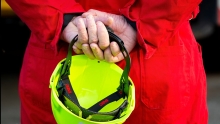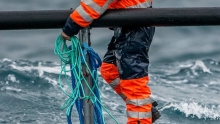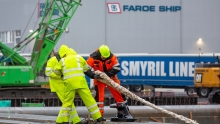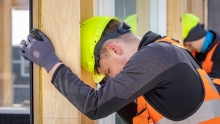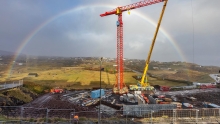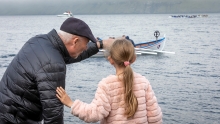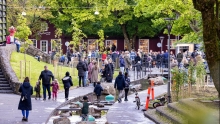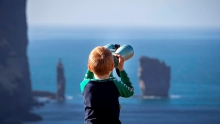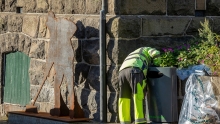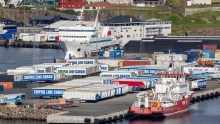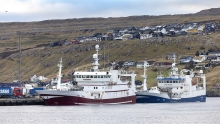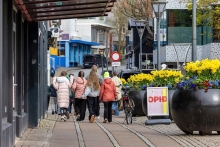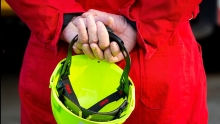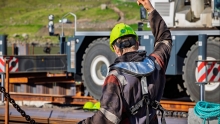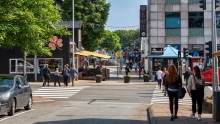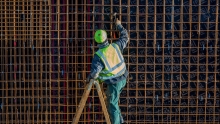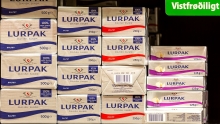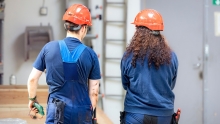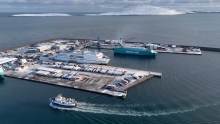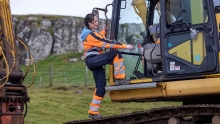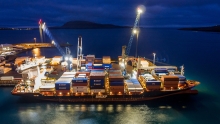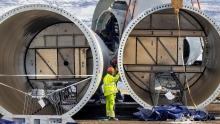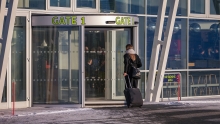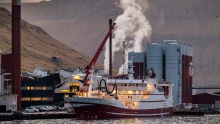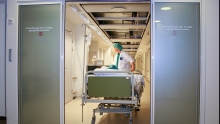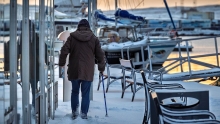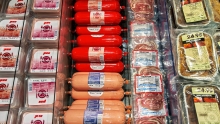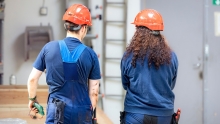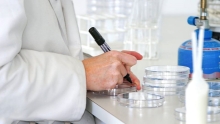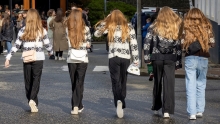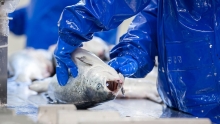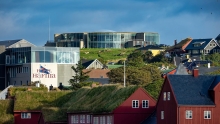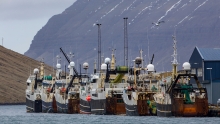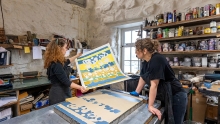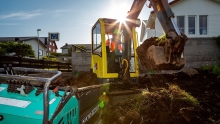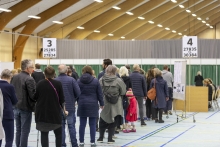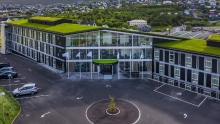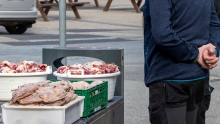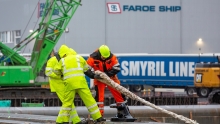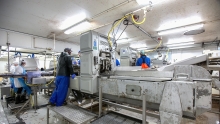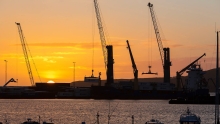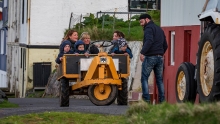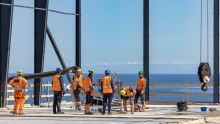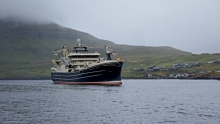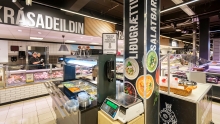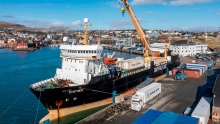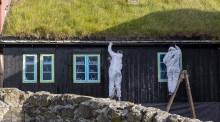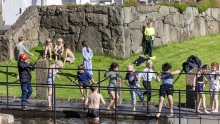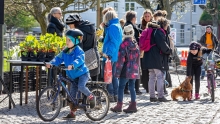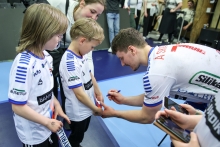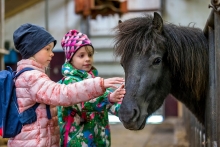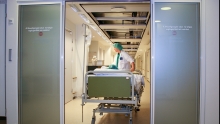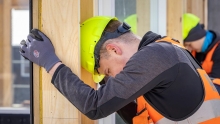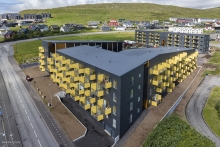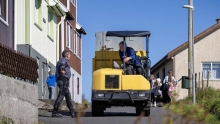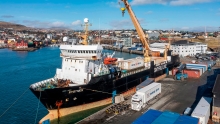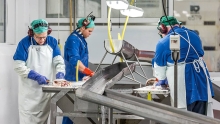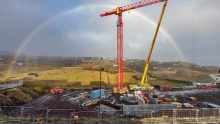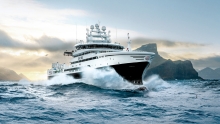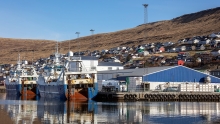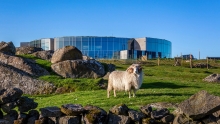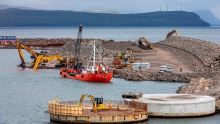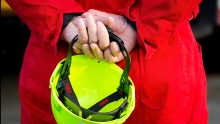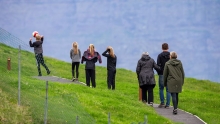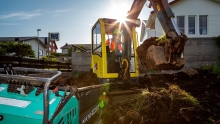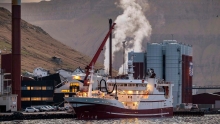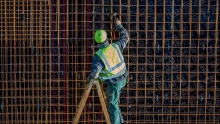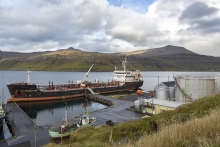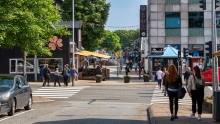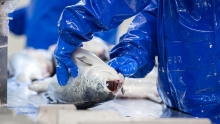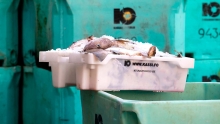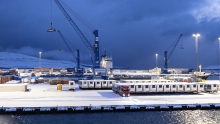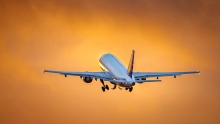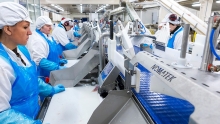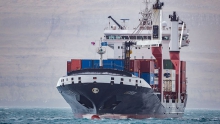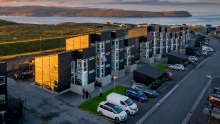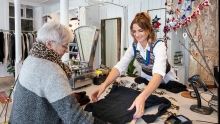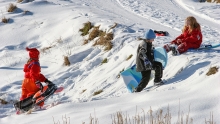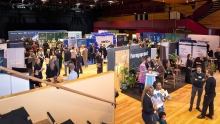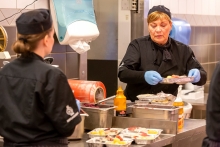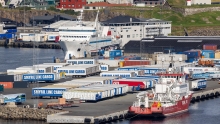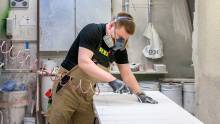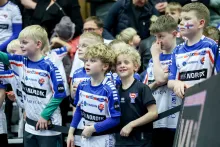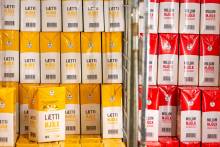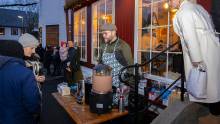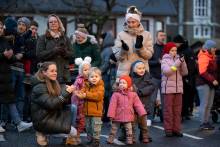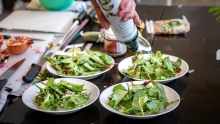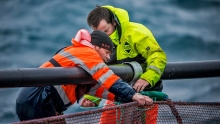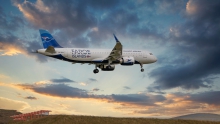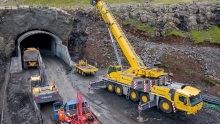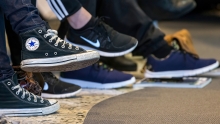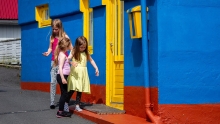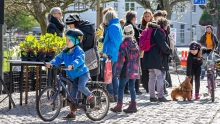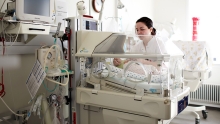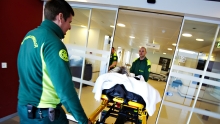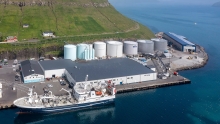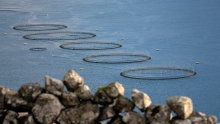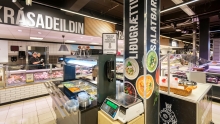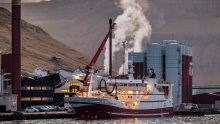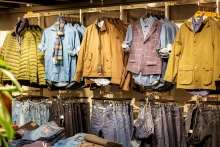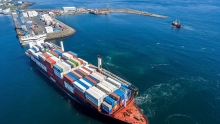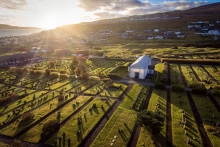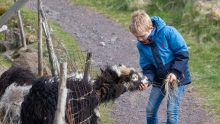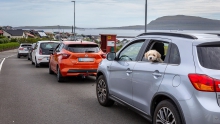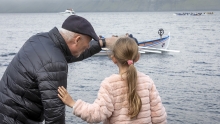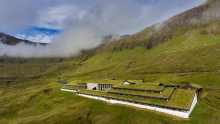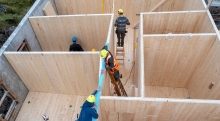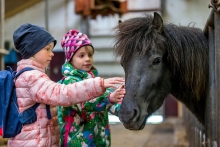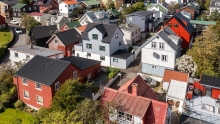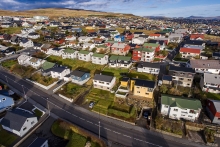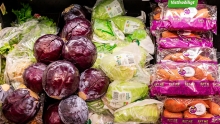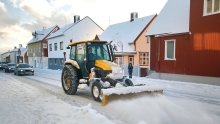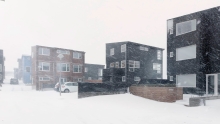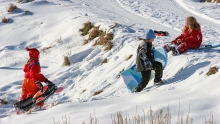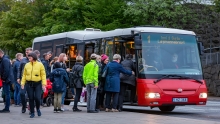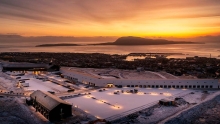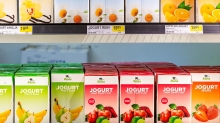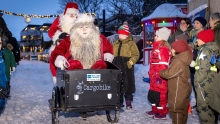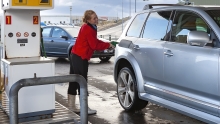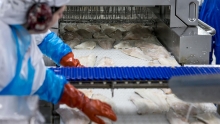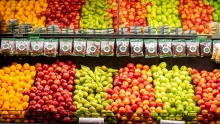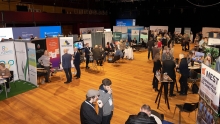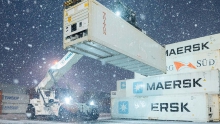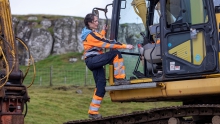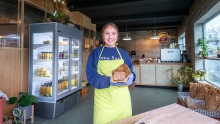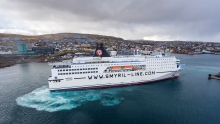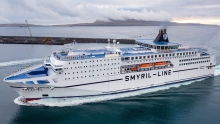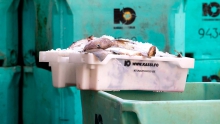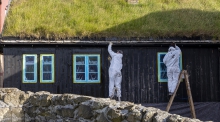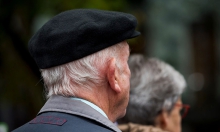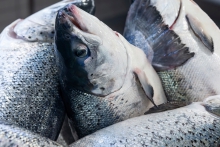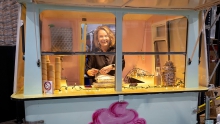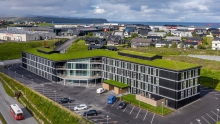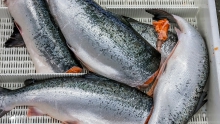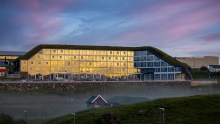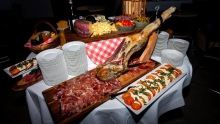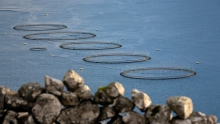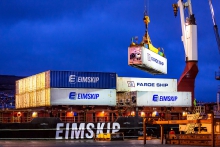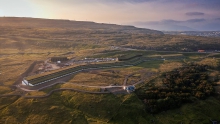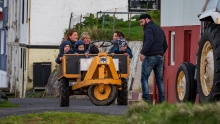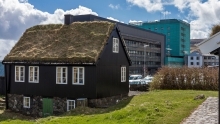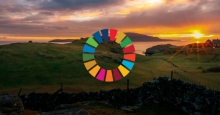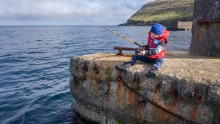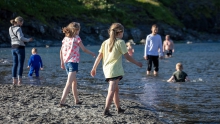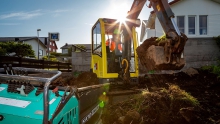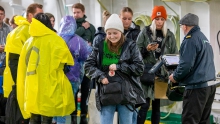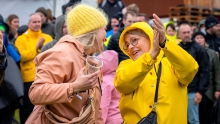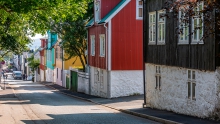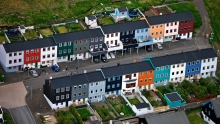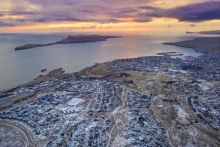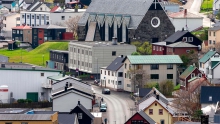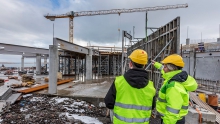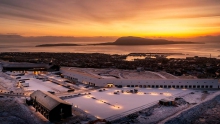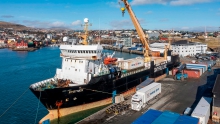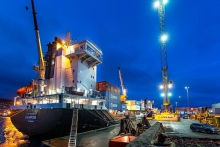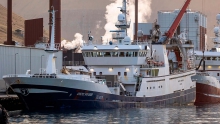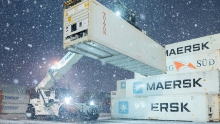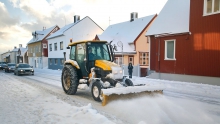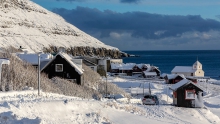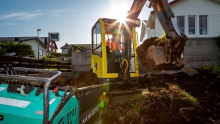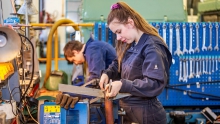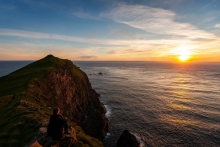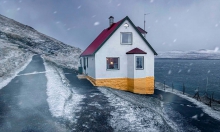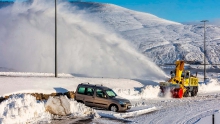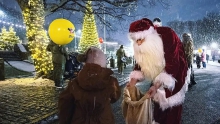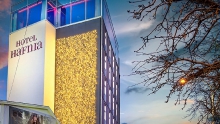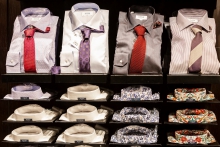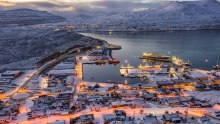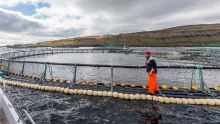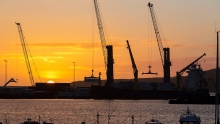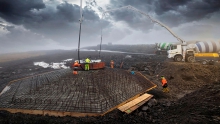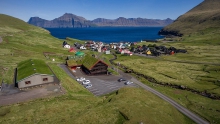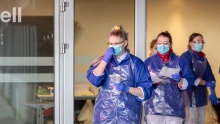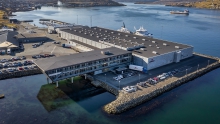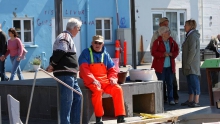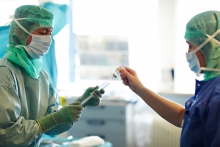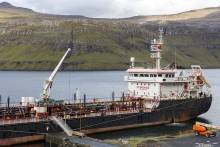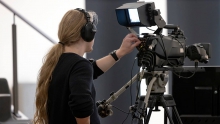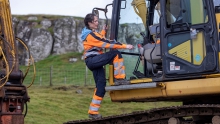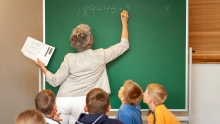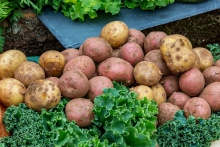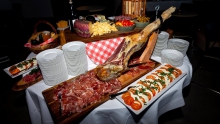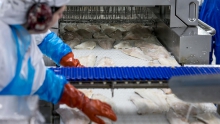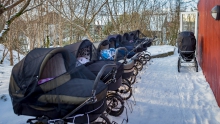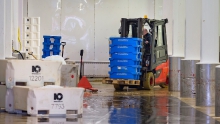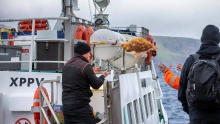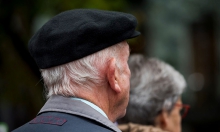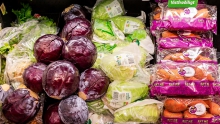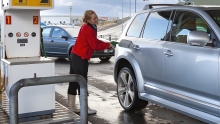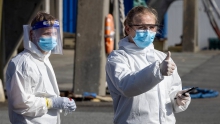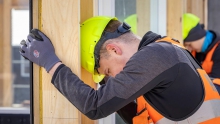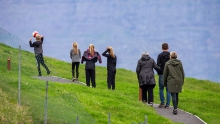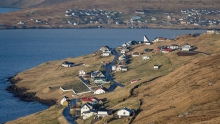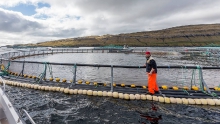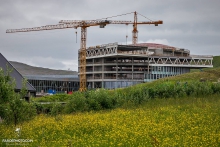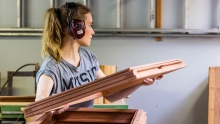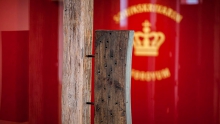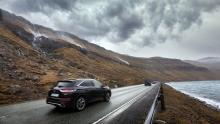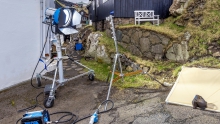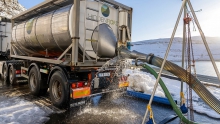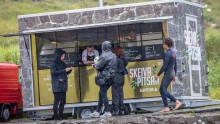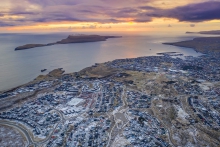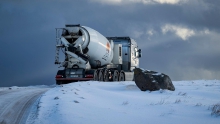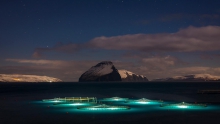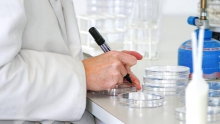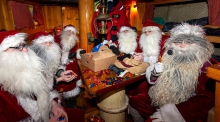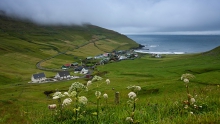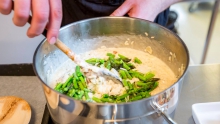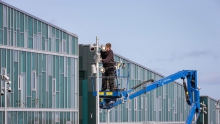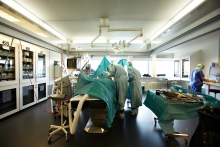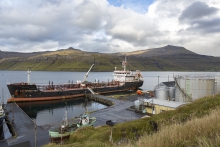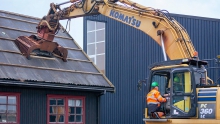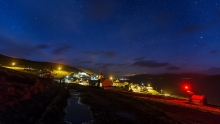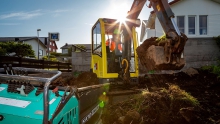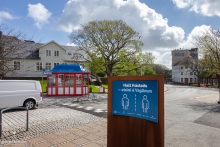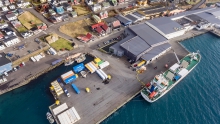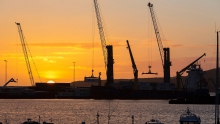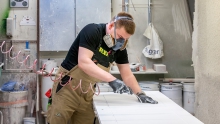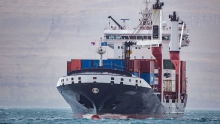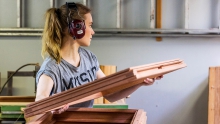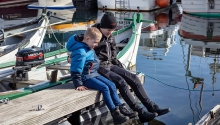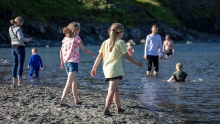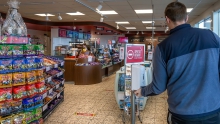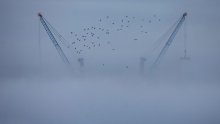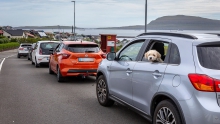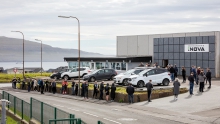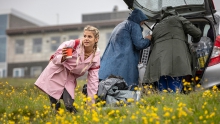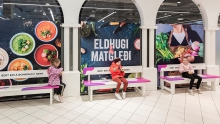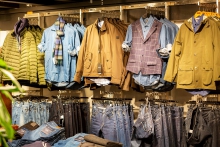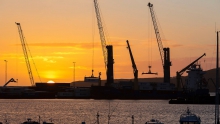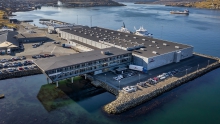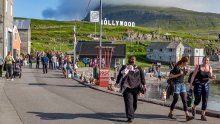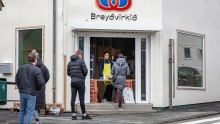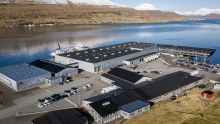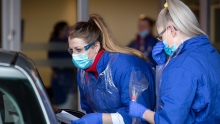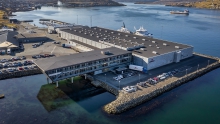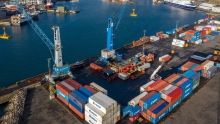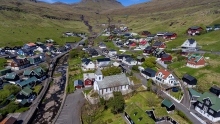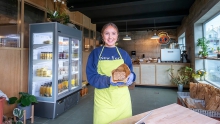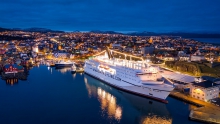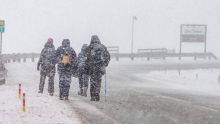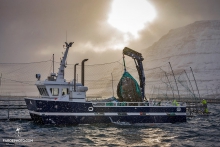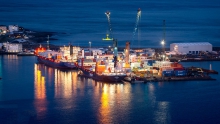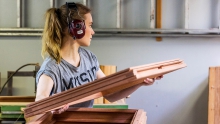The unemployment rate is down 0.1 percentage points from July 2024. Women have a lower rate than men, and Norðoyggjar is the region with the lowest rate.
News
News overview
The number of Faroese employees increased by 350 employees in July compared to July last year, a year-on-year increase of 1.2%. The largest increase was seen in fisheries and the public sector.
Men working for privately controlled employers accounted for the largest wage increase. The biggest annual wage increase was seen in demersal fisheries, up by 55%.
The Faroese population reached 55,042 on 1 July. This represents a year-on-year increase of 361 people, or 0.7%. This increase is higher than in the previous 12-month period.
The Economic Sentiment Indicator (ESI), a measure of business and consumer confidence, has fallen slightly. The construction industry is less confident, and households are less optimistic about both the overall economic outlook and their private finances 12 months from now compared to today.
The unemployment rate is down 0.1 percentage points from May 2024. Women have a lower rate than men, and Sandoy is the region with the lowest rate.
After many years of rising consumer prices, the inflation rate has been low and steady in the past year. Grocery prices continue to outpace other goods and services.
Faroese employment rose by 37 people year-on-year in May. This represents an increase of 0.1%. The number of female employees is down slightly. This is due to a decrease in women working for private employers.
Total imports amounted to just over DKK 10 billion in the May 2024 - April 2025 period. This is DKK 871.5 million (7.9%) less than in the previous 12-month period.
Total exports from May 2024 to April 2025 amounted to DKK 12.2 billion. This is a year-on-year decline of DKK 551 million.
Women working for publicly controlled employers accounted for the largest wage increase. The industrial branches with the highest wage increases were ‘Human health and social work activities’ and ‘Public administration and defence; compulsory social security’.
In 2023, 7.6% of the Faroese population was at risk of poverty. This figure has remained unchanged since 2019.
The Gini coefficient has been rising for the third consecutive year, but income inequality remains lower than in neighbouring countries.
The Faroese population reached 54,903 on 1 May. This represents a year-on-year increase of 329 people, or 0.6%. This is the same year-on-year increase as in the previous 12-month period.
750 households in the Faroes have been selected to answer 16 questions about their personal finances and their outlook on the Faroese economy as a whole.
The activity rate is the proportion of the population in the labour force, meaning they are in employment or seeking employment. In 2024 the activity rate for people in ages 15-74 was 85%, which is the highest in Europe. Compared to other countries, the Faroese rate is particularly high for women. These are findings from the annual Faroese labour force survey.
The total expenditure on research and development in the Faroe Islands amounted to 1.4% of GDP in 2023, equating to DKK 367 million. This represents a decrease of 0.3 percentage points compared to 2022, when R&D spending was 1.7% of GDP.
Faroese employment rose by 465 people year-on-year in April. This represents an increase of 1.6%. Broken down by sex and sector, the biggest increase is women working for employers under public control. However, the number of women working for private employers has gone down.
Total imports amounted to just over DKK 10 billion in the April 2024 - March 2025 period. This is DKK 1,173 million (10.5%) less than in the previous 12-month period.
Total exports from April 2024 to March 2025 amounted to DKK 12.5 billion. This is roughly the same as in the previous 12-month period.
The past 12 months saw a DKK 700 million year-on-year increase in wages. Women working for publicly controlled employers accounted for the largest wage increase (DKK 331 million).
The Faroese population reached 54,845 on 1 April. This represents a year-on-year increase of 311 people, or 0.6%, down from 0.7% in the previous 12-month period.
Faroese hotels registered about 20,300 room nights in the first quarter of this year (Q1 2025). This is a 2% year-on-year decrease. The room occupancy rate was 31%, unchanged from Q1 2024. Overnight stays fell by almost 1,000, while the number of check-ins increased by 660.
The unemployment rate is unchanged from March 2024. Women have a lower unemployment rate than men, and the Sandoy region has the lowest unemployment rate.
The total Faroese fertility rate in 2024 was 1.91 children per woman of childbearing age. This slight increase on the 1.86 figure from the previous year represents a break in the sharp decline in fertility rates seen in recent years. This is the second consecutive year with a total fertility rate below 2.0.
Faroese employment rose by nearly 500 in March year-on-year. This represents an increase of 1.7%, which distributed between the sexes is higher for women. This rate of growth is slower than observed in previous years. This is partially due to less pronounced increase of employees without long-term residency than in previous years.
Total imports amounted to DKK 10.2 billion in the March 2024 - February 2025 period. This is DKK 923 million (8%) less than in the previous 12-month period.
Total exports from March 2024 to February 2025 amounted to DKK 12.5 billion. This is around DKK 340 million less than in the previous 12-month period.
Women working for publicly controlled employers experienced the largest wage increases in the past year. ‘Agriculture, forestry and fishing’ was the only activity that saw lower year-on-year wage expenditures.
The Faroese population reached 54,784 on 1 March. This represents a year-on-year increase of 334 people, or 0.6%, down from 0.7% in the previous 12-month period.
The total unemployment rate fell by 0.1 percentage point year-on-year in February. Sandoy has the lowest unemployment rate.
Consumer prices are growing slightly faster than in November 2024. Grocery prices continue to outpace other goods and services.
Faroese employment rose by nearly 200 in February year-on-year. This represents an increase of 0.7%, equally distributed between the sexes. This rate of growth is slower than observed in previous years. Notably, the number of employees without long-term residency has shown a less pronounced increase than in previous years.
Women working for publicly controlled employers experienced the largest wage increases in the past year. Among industries, ‘Human health and social work’ and ‘Public administration and defence; compulsory social security’ saw the highest wage growth.
Total imports amounted to DKK 10.1 billion in the February 2024 - January 2025 period. This is DKK 1.1 billion (10%) less than in the previous 12-month period.
Total exports from February 2024 to January 2025 amounted to DKK 12.7 billion. This is DKK 105 million more than in the previous 12-month period.
The Faroese population reached 54,741 on 1 February. This represents a year-on-year increase of 327 people, or 0.6%, down from 0.7% in the previous 12-month period.
The total unemployment rate fell by 0.1% year-on-year in January, unchanged for men and down 0.2% for women.
Employment in the Faroes grew by more than 300 individuals between January 2024 and January 2025, representing a 1% increase. This rate of growth is slower than observed in previous years. Notably, the number of employees without long-term residency has shown a less pronounced increase than in previous years.
Total imports amounted to DKK 10.3 billion in 2024. This is DKK 1.5 billion (13%) less than in 2023.
Total exports in 2024 amounted to DKK 12.3 billion. This is DKK 405 million less than in 2023.
Women working for publicly controlled employers experienced the largest wage increases in the past year. Among industries, ‘Human health and social work’ and ‘Public administration and defence; compulsory social security’ saw the highest wage growth.
More than half of Faroese households consist of one or two adults and no children.
The Faroese population reached 54,684 at the start of this year. This represents a year-on-year increase of 292 people, or 0.5%, down from 0.7% in 2023.
The Economic Sentiment Indicator (ESI), a measure of business and consumer confidence, is rising. The service sector has registered a particularly significant increase. Retail confidence is also on the rise. Construction confidence, however, is dipping.
Faroese hotels registered a total of about 95,000 check-ins in 2024, a year-on-year increase of about 2,600. The average monthly occupancy rate in 2024 was around 50%, with an average of 545 rooms available.
The total unemployment rate in December was unchanged year-on-year, rising 0.1% for men and falling 0.1% for women.
Retail sales figures for Q3 2024 show that clothing sales climbed by 7%, while household equipment sales dipped 5%.
Total imports amounted to DKK 10.2 billion in December 2023 - November 2024. This is DKK 1.5 billion (13%) less than in the previous 12-month period.
Total exports from December 2023 to November 2024 amounted to DKK 12.5 billion. This is DKK 301 million less than in the previous 12-month period.
Employment in the Faroes grew by nearly 100 individuals between December 2023 and 2024, representing a 0.3% increase. This rate of growth is slower than observed in previous years. Notably, the number of employees without long-term residency has shown a less pronounced increase compared to prior periods.
Women working for publicly controlled employers experienced the largest wage increases in 2024. Among industries, ‘Human health and social work’ and ‘Public administration and defence; compulsory social security’ saw the highest wage growth.
The Faroese population increased by 280 people in the past year, reaching 54,675 on 1 December. This represents a 0.5% year-on-year increase, down from 0.7% in the previous 12-month period.
The Faroese unemployment rate rose by 0.1% year-on-year.
Statistics Faroe Islands is resuming its six-monthly economic tendency survey gauging Faroese households’ views on their own financial situation and the overall economy today and in the future.
Consumer price growth is slowing, rising 0.8% year-over-year. Grocery prices continue to outpace other goods and services.
Total exports from November 2023 to October 2024 amounted to DKK 12.4 billion – down DKK 370 million on the previous 12-month period.
Total imports amounted to DKK 10.1 billion in November 2023 - October 2024. This is DKK 1.5 billion (13%) less than in the previous 12-month period.
The number of employees in the Faroes increased by 178 from November 2023 to November 2024.
Just over DKK 12.7 billion was paid in wages subject to tax at source from December 2023 to November 2024.
The Faroese population increased by 250 people in the past year, reaching 54,648 on 1 November. This represents a 0.5% year-on-year increase, down from 0.8% in the previous 12-month period.
The statbank now includes historical labour force statistics from 1834 to 1977.
For the second consecutive year, Statistics Faroe Islands looks at how much research and development (R&D) is carried out by Faroese businesses and institutions. The survey is recurring and now covers R&D conducted in 2023.
About a third of Faroese long-term residents who still reside abroad and who are registered in Denmark as having a skills-based qualification have been educated within health and welfare.
A fifth of Faroese and a tenth of Icelanders emigrate and never return. While Iceland has seen improvement in resident retention rates across generations, the Faroese rate remains more or less unchanged.
The Faroese unemployment rate remained unchanged year-on-year in October.
The Faroes swung from DKK 2 billion in liabilities in 2022 to net assets in 2023.
The 2023 current accounts reveal a balance of payments surplus of DKK 1.3 billion.
Total exports from October 2023 to September 2024 amounted to DKK 11.9 billion - down DKK 1.1 billion on the previous 12-month period
Total imports amounted to DKK 10.7 billion in October 2023 - September 2024. This is DKK 833.2 million (7%) less than the previous 12-month period.
The number of employees in the Faroes increased by 470 from October 2023 to October 2024.
Almost DKK 12.7 billion was paid in wages subject to tax at source in the 12-month period from November 2023 to October 2024.
The Faroese population increased by 309 people in the past year, reaching 54,668 on 1 October. This represents a 0.6% year-on-year increase, down from 0.8% in the previous 12-month period.
Faroese hotels registered 93,742 overnight stays in the third quarter (Q3) of this year – an increase of 13.7% on Q3 2023. The profile of hotel guests' countries of residence is changing.
The Faroese unemployment rate was up 0.1 percentage points compared to September 2023.
In comparison, less than 40% of female employees work for employers under private control.
DKK 12.5 billion was paid in wages subject to tax at source from October 2023 to September 2024. This is a year-on-year increase of DKK 640 million (5.3%).
Total exports amounted to DKK 11.9 billion from September 2023 to August 2024 – more than DKK 1 billion less than the previous 12-month period.
Total imports amounted to DKK 10.6 billion in September 2023 - August 2024. This is DKK 955.7 million (8%) less than the previous 12-month period.
The number of employees in the Faroes increased by 231 from September 2023 to September 2024.
More than half of companies in the Faroes with ten employees or more innovate. Faroese companies are among the most innovative in the Nordics and Europe.
The Faroese population increased by 303 people in the past year, reaching 54,679 on 1 September. This represents a 0.6% year-on-year increase, down from 0.9% in the previous 12-month period.
Government outlays totalled DKK 13.2 billion in 2023, a year-on-year increase of DKK 1.2 billion (9.2%). Local and national investments in sports facilities and tunnels are the main drivers of the spending rise.
While many European economies are experiencing slowdown, the Faroese economy is still growing.
Consumer price growth is slowing down. Prices rose 1.7% from August 2023 to August 2024, which is the slowest price growth in more than three years.
The industries with the highest profits in 2023 were ‘Aquaculture’, ‘Pelagic fisheries’ and 'Processing and preserving of fish and crustaceans and molluscs'.
The Gini coefficient was 22.2 in 2022, compared with 21.5 the previous year. The income quintile ratio rose 0.1.
In 2022, 7.6% of the Faroese population was at risk of poverty. This is about the same figure as in 2021, 2020 and 2019.
Household equipment sales fell by 17% from Q2 2023 to Q2 2024.
The unemployment rate is up 0.2 percentage points year-on-year.
Fish exports in the first seven months of 2024 amounted to DKK 6.3 billion – down DKK 292.4 million on the same period in 2023.
Total imports amounted to DKK 5.9 billion in the first seven months of 2024. This is DKK 981.7 million (14%) less than the same period in 2023.
The number of employees in the Faroes increased by 280 from August 2023 to August 2024.
A total of 54,908 people resided in the Faroes on 1 August, a year-on-year growth of 0.5%
Just over 45% of Faroese people have a surname ending with -sen. In 1985, this figure was above 60%.
Although Jákup and Maria have been the most common Faroese names for many years, the composition of names has changed in recent years. Lív has entered the top-10 list of women’s names, while Jónas is the latest addition to the most common men’s names.
Brandur, the most popular name in 2022, has moved down to second on the list.
This is the first time that Tóra tops the annual list of popular baby girl names.
The number of employees in the Faroes increased by 300 from July 2023 to July 2024.
The unemployment rate is up 0.4 percentage points year-on-year.
One in four households consists of only one person.
The Faroese population increased by 333 people from 1 July 2023 to 1 July 2024. This annual increase of 0.6% is lower than in the previous 12-month period.
Total imports amounted to DKK 5.1 billion in the first half (H1) of 2024. This is a DKK 852 million (14%) drop on H1 2023.
Fish exports in the first half (H1) of 2024 amounted to DKK 5.5 billion – down DKK 158.7 million (4%) on H1 2023.
A total of DKK 12.4 billion was paid in wages subject to tax at source from July 2023 to June 2024. This is an increase of about DKK 700 million (5.8%) on the previous 12-month period.
The Economic Sentiment Indicator (ESI), a measure of business and consumer confidence, is declining. Sentiment appears particularly low in the primary sector and industry. Construction is also showing signs of growing pessimism. However, retail confidence is on the increase.
Total exports from June 2023 to May 2024 amounted to DKK 12.4 billion – down DKK 516.9 million (4%) on the previous 12-month period.
Total imports amounted to DKK 10.7 billion from June 2023 to May 2024. This is a decrease of DKK 1.6 billion (13%) on the previous 12-month period.
The Faroese population increased by 323 people from 1 June 2023 to 1 June 2024. This annual increase of 0.6% is lower than in the previous 12-month period.
Consumer prices continue to grow, rising 3.0% from May 2023 to May 2024. Housing costs, including mortgage rates and heating oil, are the most important drivers of inflation in the past year. Food price inflation has moderated compared to the previous two years.
Faroes see 17.8% drop in material consumption since 2020.
Cosmetics sales surged 12% year-on-year in Q1 2024, with volume sales up 10% after adjusting for inflation.
In 2022, the Faroes spent DKK 376 million on research and development. This represents 1.5% of its GDP, compared with 0.9% in 2003.
The unemployment rate is up 0.2 percentage point year-on-year.
Total imports amounted to DKK 11 billion from May 2023 to April 2024. This is a decrease of DKK 1.6 billion (12%) on the previous 12-month period.
Total exports from May 2023 to April 2024 amounted to DKK 12.8 billion – down DKK 449 million (3.4%) on the previous 12-month period. Fish exports, however, are up 1% year-on-year.
The Faroese population increased by 383 people from 1 May 2023 to 1 May 2024. This annual increase of 0.7% is slightly lower than in the previous 12-month period.
The unemployment rate is up 0.3% year-on-year.
Total exports from April 2023 to March 2024 amounted to DKK 12.5 billion – down DKK 552 million on the previous 12-month period.
The Faroese population increased by 420 people from 1 April 2023 to 1 April 2024. This is an increase of 0.8%, slightly less than in the previous 12-month period.
The life expectancy trend remains unchanged: we live longer.
Faroese hotels registered almost 31,800 overnight stays in the first quarter of 2024, up 1% year-on-year. There were about 20,800 room nights, amounting to an occupancy rate of 31%. A shift is emerging in the origin of hotel guests.
Traditionally higher than elsewhere, the Faroese fertility rate has dipped below 2.0 for the first time and now aligns more with European norms.
The unemployment rate for March was 1.1%, up 0.3% from March 2023.
Total exports from March 2023 to February 2024 amounted to DKK 12.8 billion. This is DKK 47 million less than in the previous 12-month period.
Total imports amounted to DKK 11.1 billion from March 2023 to February 2024. This is a decrease of DKK 1.4 billion (11%) on the previous 12-month period.
The Faroese population increased by 439 people from 1 March 2023 to 1 March 2024. This annual increase of 0.8% is lower than in the previous 12-month period.
Consumer prices rose 2.6% from February 2023 to February 2024. In other words, consumer prices continue to grow, but the growth is slowing down. Higher mortgage and interest rates for households continue to be the most important drivers of inflation in the past year.
Sales of cosmetics rose by 10% year-on-year in Q4 2023. Adjusted for inflation, the cosmetics volume sales rose by 3%.
The unemployment rate for February was 1.1%, up 0.3% from February 2023.
Total exports increased by DKK 12.6 billion from February 2023 to January 2024. This is DKK 30 million less than in the previous 12-month period.
Total imports amounted to DKK 11.2 billion from February 2023 to January 2024. This is a decrease of DKK 1.2 billion (9.4%) on the previous 12-month period.
The Faroese population increased by 450 people from 1 February 2023 to 1 February 2024. This annual increase of 0.8% is slightly lower than in the previous 12-month period.
At age 20, about 40% of each generation moves abroad. Only half of these people return permanently.
The unemployment rate for January was 1.0%, up 0.1% from January 2023.
94% of Faroese residents have lived and been active in the Faroes for extended periods, qualifying them as having ‘long-term residency’. Ten years ago, this figure was 98%.
Fish exports increased 4.3% in value and 26% in volume year-on-year in 2023.
Total imports for 2023 amounted to DKK 11.8 billion.
One in four households consists of only one person.
Just over DKK 940 million was paid in wages in January. This is an increase of DKK 72 million (8.3%) on January 2023.
December typically has the highest employee count, while January tends to have the lowest. The difference in employee numbers is usually significant. In December 2023, it was 28,500 and in January 2024 it was 27,664.
The Faroese population increased by 450 people in the past year, reaching 54,545 on 1 January 2024. This annual increase of 0.8% is slightly lower than in the previous 12-month period.
The Economic Sentiment Indicator (ESI), which measures the consumers’ and businesses’ expectations of the economic situation, is falling. Optimism is particularly low in the retail and service industries, while the construction industry remains confident. The consumer outlook holds steady.
The Faroes have the lowest unemployment rate in Europe. The rate for 2023 matches pre-pandemic levels. Unemployment for Faroese women is exceptionally low.
Overnight stays in Faroese hotels fell 4% from the record highs of 2022, but the occupancy rate held steady.
Of the roughly 38,900 people in the 15-74 age bracket, just over 32,600 form part of the labour force. The labour force has declined slightly compared to 2022, while the inactive population has increased.
The Faroes imported goods worth DKK 10.9 billion in the first 11 months of 2023.
Fish exports for the first 11 months of 2023 amounted to DKK 10.9 billion, an increase of DKK 489 million over the same period in 2022.
December is traditionally the month with the highest employee figure. December 2023 was no exception, reaching a record-high figure of 28,740 employees.
The Faroese population increased by 478 people from 1 December 2022 to 1 December 2023. This is an increase of 0.9%, slightly less than in the previous 12-month period.
Consumer prices increased by 2.8% from November 2022 to November 2023. In other words, consumer prices continue to grow, but the growth is slowing down. Higher mortgage and interest rates for households were the most important drivers of inflation in the past year.
Retail sales figures for Q3 2023 – now reported in accordance with Eurostat standards – reveal a decline in sales of food, clothing and cosmetics.
The Faroes imported goods worth DKK 10.1 billion in the first ten months of this year.
Fish exports totalled DKK 9.8 billion in the first ten months of this year, an increase of DKK 450 million over the same period last year.
Workers from overseas account for the largest share of employee growth.
The Faroese population increased by 545 people from 1 November 2022 to 1 November 2023. This is an increase of 1%, the same as in the previous 12-month period.
The unemployment rate has been below 1% since April 2022.
Fish exports totalled DKK 7.8 billion in the first nine months of this year, an increase of DKK 556 million over the same period last year.
The Faroes imported goods worth DKK 8.7 billion in the first nine months of this year.
The Faroese population increased by 554 people in the past year. This marks a year-on-year increase of 1%, slightly less than in the previous 12-month period.
Fish exports totalled DKK 7.8 billion in the first eight months of this year, an increase of DKK 491 million over the same period last year.
The Faroes imported goods worth DKK 7.8 billion in the first eight months of this year.
The tax level in the Faroes was 40.6% of GDP in 2022. The government collected more taxes in 2022 than in previous years. But GDP grew faster than tax revenues, resulting in a falling tax level.
Just over 54,500 people lived in the Faroes on 1 September. This is an increase of 576 people (1.1%) in the past year, compared to a 1.0% increase in the previous 12-month period.
Consumer prices continue to grow, but the growth is slowing down. High grocery and electricity prices along with rising interest rates remain the most important drivers of inflation in the past year.
The highest profits in 2022 were reported in the ’Agriculture, forestry and fishing’, ‘Manufacturing’ and ‘Wholesale and retail trade: Repair of motor vehicles and motorcycles’ industrial sections. The highest percentage earnings growth came in ‘Transportation and storage’ and ‘Arts, entertainment and recreation’.
The 2022 current accounts reveal a slightly lower balance of payments surplus than in 2021.
Government spending amounted to DKK 12 billion in 2022. Almost DKK 2 billion was spent on ‘old age’ and DKK 1.4 billion on ‘transport’.
The Faroese economy has recovered well after the slump caused by the Covid-19 pandemic. The GDP growth in fixed prices was 5.4% in 2022 and 5.8% in 2021. This growth rate is higher than in most countries that the Faroes usually compare themselves to.
Consumer price growth is coming down but prices remain high, and that is reflected in retail sales. Although the highest price hikes in the three main commodity groups were registered in groceries, sales of clothing have been affected the most by rising prices.
The Faroes imported goods worth DKK 6.9 billion in the first seven months of this year.
Fish exports totalled DKK 6.6 billion in the first seven months of this year, an increase of DKK 380 million over the same period last year.
Eva has been among the most popular baby girl names in recent years. Elvira is a new addition to this list.
Although Jákup and Maria have been the most common Faroese names for many years, naming trends are changing. Lív and Hanna are now among the most popular women’s names, while Jónas is the latest entry to the list of popular men’s names.
For the first time, Baldur, Brandur and Kristian top the list of popular boy’s names.
The portion of the population at risk of poverty was 7.7% in 2021, about the same as in the previous two years.
The Gini coefficient and the income quintile ratio (also known as the ‘S80/S20 ratio’) are two of the most common metrics used for describing a nation’s income distribution.
The population increased by 641 people in the past year, reaching a total of 54,738 on 1 August 2023. This represents a 1.2% year-on-year increase, a slightly higher annual increase than in the previous 12-month period.
The Faroese population increased by 609 people in the past year, reaching a total of 54,601 on 1 July 2023. This growth is slightly lower than in the previous 12-month period.
The Faroes imported goods worth DKK 5.9 billion in the first half of this year.
Fish exports increased by DKK 356 million in the first half of this year, compared to the same period last year.
Denmark, the Faroes and Norway have the highest per capita number of healthcare staff in hospitals out of the 20 European countries for which such statistics are available
The number of annual full-time equivalents (FTE) per 1,000 population in Faroese hospitals increased from just over 15 to almost 16 in the past ten years.
Exports of fish products increased by DKK 1.5 billion from June 2022 to May 2023 compared with the previous 12-month period.
Total imports, excluding vessels and aircraft, from June 2022 to May 2023 amounted to DKK 11.1 billion, a year-on-year increase of DKK 1.1 billion.
The Faroese population increased by 591 people in the past year, reaching a total of 54,503 on 1 June 2023. This represents a 1.1% year-on-year increase, slightly less than in the previous 12-month period.
Consumer prices continue to grow, but the growth is slowing down. The Consumer Price Index increased by 4.4% in the past year. The latest annual increase in price levels is mostly due to higher grocery prices and rising interest rates, while lower fuel prices are keeping inflation in check.
The Economic Sentiment Indicator (ESI) is falling and is significantly lower than in the previous two surveys. Confidence levels vary across the sectors, with optimism waning in the industry and retail, while consumer confidence remains stable.
Consumer price growth is coming down, but prices remain high, and that is reflected in retail sales. Although the highest price hikes in the three main commodity groups were registered in groceries, sales of clothing have been affected the most by rising prices.
About 26,500 overnight stays were registered in May – an 11% year-on-year decrease.
The total number of GP visits in 2022 was 181,348, a 2% increase on 2021. About 9,200 of these consultations were carried out over the phone due to the risk of Covid-19 infection. People residing abroad accounted for about 2.5% of the total number of GP consultations.
Total imports, excluding vessels and aircraft, from May 2022 to April 2023 amounted to DKK 11.2 billion, a year-on-year increase of DKK 1.5 billion.
Faroese exports of fish products increased by DKK 1.8 billion from April 2022 to March 2023 compared to the previous 12-month period.
The Faroese population increased by 572 people in the past year. This represents a 1.1% year-on-year increase, which is slightly less than in the previous 12-month period.
Mortality rates have changed significantly for both sexes since the turn of the century. There are now far fewer cardiovascular deaths, while the figures for the other main cause of death, cancer, have remained relatively stable.
Faroese exports of fish products increased by DKK 1.8 billion from April 2022 to March 2023 compared to the previous 12-month period.
Total imports from April 2022 to March 2023 amounted to DKK 12.7 billion, a year-on-year increase of DKK 2.6 billion.
Since the start of this century, the Faroese fertility rate has averaged at about 2.5 children for women of childbearing age (15-49). This figure has, however, gone down significantly in the past four years, dropping to 2.4 in 2019, 2.3 in 2020 and 2021 all the way down to 2.05 last year.
The Faroese population increased by 569 people in the past year. This represents a 1.1% year-on-year increase, which is slightly less than in the previous 12-month period.
Traffic statistics in the Faroe Islands have changed significantly since the turn of the century, with twice the number of vehicles and two-thirds fewer accidents.
The average life expectancy in the Faroes is 85.4 years for women and 81.3 years for men. This figure has been on a steady rise for both sexes in recent years.
The overall number of reported criminal offences has more than halved over the past 16 years, going from 1,100 cases in 2007 to 532 in 2020. One figure stands out in this context: the past five years have seen a massive increase in reported sex crimes.
Fewer people have been imprisoned and held in custody in the past two decades, but the number of prison days has not seen a corresponding decline. Reported violations of the drug law are on the rise.
The past decade has seen a massive increase in residence and work permits issued to foreign nationals. The biggest annual increase was registered last year.
Consumer prices continue to rise, but the growth is slowing down. The Consumer Price Index increased by 8.3% in the past year, mostly due to higher interest rates and rising energy prices.
The Faroese population increased by 608 people in the past year. This represents a 1.1% year-on-year increase, which is slightly less than in the previous 12-month period.
Total imports from March 2022 to February 2023 amounted to DKK 12.8 billion. This marks a year-on-year increase of DKK 3.3 billion.
Faroese exports of fish products increased by DKK 2.1 billion from March 2022 to February 2023 compared to the previous 12-month period.
Just under 14,000 land registration documents were filed in 2022. This is 1% less than in 2021. Real estate documents, which made up the vast majority, increased by 7%, while there was a 26% decrease in documents relating to vehicles.
About a third of all of last year’s sales of dwelling houses took place in villages, one-third in towns and about a third in Tórshavn. But the average house price in the capital was about twice that of a village house.
Retail sales tend to grow from Q3 to Q4 due to the Christmas sales season, and last year was no exception. However, retail sales measured in real prices dropped across all commodity groups in Q4 2022 compared to the same period in 2021. Although the biggest price hikes were in groceries, sales of clothing and footwear have been affected the most by the rising prices.
Eysturoy and Vágar have the lowest unemployment rate.
Total imports in the February 2022 - January 2023 period amounted to DKK 12.6 billion. This an increase of DKK 3.2 billion on the previous 12-month period.
Faroese exports of fish products increased by DKK 2.1 billion from February 2022 to January 2023 compared to the previous 12-month period.
The Faroe Islands have enjoyed rapid population growth over the past eight years. This period has also seen great activity in construction. The number of new dwellings is rising fast, though not as fast as the population figure.
The Faroese population increased by 634 people in the past year. This represents a 1.2% year-on-year increase, which is slightly less than the previous 12-month period.
Homeless hostels were fully occupied practically every day last year.
Key figures in the national accounts are now available in current prices for the first time. This makes it possible to compare real GDP growth with other countries for the 2009-2021 period.
Faroese residents accounted for nearly half of all hotel overnight stays in January 2023.
Unemployment is highest in the 25-34 age group and lowest in the 45-54 group.
Total imports amounted to DKK 12.1 billion in 2022, a year-on-year increase of 31%.
Faroese exports of fish products increased by DKK 2.4 billion in 2022. This represents a year-on-year increase of 26% in export value. The total export volume went down by 6%.
On 1 January 2023, the Faroese population was 54,255. This is an increase of 678 people (1.3%) in the past year, the same percentage increase as in the previous 12-month period.
The Economic Sentiment Indicator (ESI) is falling as the confidence levels are lower than in the previous two surveys. Confidence levels vary across the industrial sectors. Optimism is waning in the service and primary sectors, while households have a brighter outlook on the future.
The almost 230,000 hotel overnight stays registered in 2022 are the highest ever annual figure. The occupancy rate was, however, lower than in 2019.
The Faroese labour force differs from that of other countries in many respects. For example, women, the young and the old are significantly more occupationally active than elsewhere.
Out of almost 38,700 people in the Faroes aged 15-74, just below 32,900 are part of the labour force. Just over 5,800 people in this age group are thus not considered part of the labour force.
The Consumer Price Index increased by 10.1% in the past year. Prices of most categories of goods and services have gone up, but prices of groceries and heating fuel still contribute most to the overall price increase.
December 2022 saw a 0.9% year-on-year increase in employees. This growth is to a large extent represented by employees with non-Danish citizenship.
Imports in the first 11 months of 2022 increased by a third year-on-year.
The Faroe Islands exported fish products to the value of DKK 10.4 billion in the first 11 months of 2022.
The fishery and other natural resources sector saw the biggest increase in wages in 2022.
On 1 December 2022, the Faroese population was 54,227. This is an increase of 620 people (1.2%) in the past year, compared to a 1.4% increase in the previous 12-month period.
Faroese retail sales have been affected by global price hikes, with the sales volume dropping in all three main retail sales categories. From Q3 2021 to Q3 2022, the clothing and footwear category saw a 15% drop in sales volume, ‘furnishings and household equipment’ went down 13% and ‘food and non-alcoholic beverages’ dropped by 9%.
Faroese hotels registered just over 8,000 overnight stays in November, which is a quarter less than in November 2021.
The unemployment rate is 0.7% for both sexes. In Vágar and Eysturoy, the rate is 0.4%.
Imports in the first 10 months of 2022 have surpassed the total for 2021
Fish exports amounted to DKK 9.3 billion from January to October 2022.
Just over 54,150 people lived in the Faroes on 1 November. This is an increase of just over 600 people (1.1%) in the past year, compared to a 1.5% increase in the previous 12-month period.
The unemployment rate has been at 0.7% since August this year. The rate in Eysturoy is 0.3%.
The annual labour force survey for 2022 is taking place from November .21st to 25th
Total imports in the first 9 months of this year amounted to DKK 9.3 billion, which is a record.
Fish exports amounted to DKK 8.3 billion from January to September 2022.
Just over DKK 900 million was paid in wages in October, an increase of DKK 55 million (6.4%) on October last year.
October 2022 saw a year-on-year increase of almost 500 employees.
The Faroese population was just over 54,100 on 1 October. This is a year-on-year increase of 1.2% compared to 1.4% in the previous 12-month period.
Public spending amounted to DKK 11.7 billion in 2021. The figures show how the government prioritises spending on social protection, health, education, etc. A notable figure is that almost DKK 2 billion was spent on ‘old age’.
In 2021, companies in the ‘Aquaculture’ branch paid out DKK 335 million, the ‘Manufacture of food products’ branch paid DKK 395 million and ‘Wholesale and retail trade; Repair of motor vehicles and motorcycles’ paid DKK 445 million in dividends
In August and September, the unemployment rate was 0.5%, equivalent to 150 full-time unemployed people.
Faroese hotels registered about 23,400 overnight stays in September. Foreign hotel visitors are returning while the number of Faroese visitors is declining.
The Consumer Price Index (CPI) measures inflation as experienced by consumers in their daily living expenses.
Total imports in the first 8 months of this year amounted to DKK 8.3 billion.
Fish exports amounted to DKK 11.2 billion from September 2021 to August 2022. In the first 8 months of this year, fish exports increased by 35% compared to the same period last year.
GDP growth resumed in 2021 after the pandemic slump in 2020. The GDP in current prices was just short of DKK 23 billion, or DKK 431,000 per capita. This marks a year-on-year GDP growth of DKK 1.7 billion (8%).
The 2021 current accounts show a slightly higher balance of payments surplus than in 2020.
Municipalities are generally becoming increasingly indebted as operational costs and investments exceed revenues from taxes and duties.
The Faroese population was 54,081 on 1 September, increasing by 636 people (1.2%) in the past year, compared to a 1.6% increase in the previous 12-month period. The reduced growth is mainly due to a lower excess of births over deaths.
The number of hotel overnight stays during the summer has more than doubled since 2013 when records began. June, July and August 2022 saw almost 97,000 stays compared to 44,000 in the same months of 2013.
Sales of clothing and footwear have dropped well below the average for previous years, but the rising prices have not affected sales of groceries and household equipment.
Total sales of medicine in Faroese pharmacies have increased from DKK 118 million to DKK 292 million over the past 20 years. The largest increase has been in the aquaculture industry, where sales increased from about DKK 20 million to DKK 111 million in the past 20 years. Medicinal sales to the aquaculture industry make up 38% of total medicine sales in pharmacies.
Fish exports amounted to DKK 6.1 billion from January to July, an increase of DKK 1.4 billion on the same period last year.
Total imports from January up to and including July 2022 amounted to DKK 6.9 billion, an increase of DKK 1.9 billion compared to the same period last year.
Just under DKK 900 million was paid in wages in August, a year-on-year increase of almost DKK 70 million, or 8%.
There were just under 27,600 employees in August, a year-on-year increase of about 260 employees.
The Faroese population reached 54,200 on 1 August, increasing by 670 people (1.3%) in the past year, compared to a 1.5% increase in the previous 12-month period.
There were 32 legally induced abortions in 2021. This is above the average annual figure of 25 over the past eight years. The figure is now at about the same level as a decade ago, though far lower than the period from the 1980s to 2004 – and still by far the lowest in the Nordic region.
Statistics Faroe Islands today launched a website that showcases the Faroe Islands’ progress toward meeting the Sustainable Development Goals.
The list of popular names has changed significantly in the past 20 years.
Of the ten most popular baby names in 2021, Jónas and Lív are the only ones that featured in the top-10 in 2001.
Total imports from January 2022 to June 2022 amounted to DKK 5.8 billion, an increase of DKK 1.5 billion on the first half of last year.
The fish export value increased by DKK 1.3 billion in the first half of 2022 compared to the first half of 2021
The Faroese population reached 54,072 on 1 July 2022, increasing by 698 people (1.3%) in the past year, compared to a 1.5% increase in the previous 12-month period. The growth over the past year is made up of an excess of births of 163 children and a net migration figure of 535.
Consumer prices continue to rise. Q2 2022 saw a 7.3% increase on Q2 2021, which is the highest annual increase in 14 years.
Just under DKK 950 million was paid in wages in June, a year-on-year increase of almost DKK 80 million, or just over 9%.
Total imports from June 2021 to May 2022 amounted to DKK 10.7 billion, a year-on-year increase of 28%.
The total export value increased by DKK 3 billion in the June 2021-May 2022 period compared to the previous 12 months.
There were just under 28,100 employees in June, which is the highest-ever monthly figure. The only previous time the number of employees exceeded 28,000 was in December 2021.
The Faroese population continues to increase. On 1 June, the population figure surpassed 54,000, a year-on-year increase of 1.3%. The slight drop in the relative growth is mainly due to a decrease in the excess of births over deaths.
There were 265 full-time unemployed people in April 2022
The Economic Sentiment Indicator (ESI) is at the exact same level as in the previous survey from January, shortly before Russia’s invasion of Ukraine. Households have a more pessimistic outlook of the economic situation, and the trade and construction industry are less optimistic than before. On the other hand, the ‘Primary sector and industry’ and ‘Services’ industrial sectors, which affect the confidence index the most, are more optimistic.
Far more non-Faroese residents and fewer Faroese residents visited hotels in the past year.
Sales of ‘groceries and non-alcoholic drinks’ and ‘furnishings and household equipment’ declined significantly, while ‘clothing and footwear’ saw a more modest decline compared to previous years.
The Faroe Islands top the European list of domestic materials consumption per capita
The Faroese population for March 2022 has increased by 730 people, which is a year-on-year growth of 1,4% on March 2021. In comparison, the year-on-year growth for February was 1.5%.
There were 11,800 hotel overnight stays registered in March 2022, a year-on year increase of 23%. Just over 39% of all available rooms were occupied, compared to 29% last year.
The consumer prices for Q1of 2022 rose by 4.4% from Q1 2021. This represents the most highest CPI change in the course of one year since the global financial crisis of 2009, both in terms of the Faroe Islands as well as globally.
The Faroese population for March 2022 has increased by 730 people, which is a year-on-year growth of 1,4% on March 2021. In comparison, the year-on-year growth for February was 1.5%.
Milk production has increased by 10% during the past ten years. However, the number of farms that include dairy cattle has reduced from 28 farms in 2012 to 16 farms in 2021. Beef production has also increased slightly in the same period.
Some 14,000 land registration documents were filed in 2021, which is a 6% increase on 2020. Real estate documents, which made up the vast majority, increased by 3%. A 16% increase in documents relating to vehicles, and a 11% decrease in documents relating to personal property.
Q4 2021 retail sales figures show 'clothing and footwear' has increased by 29%. Despite the usual increase in sales from Q3 2021 to Q4 2021, all commodity groups saw a decline in the period Q4 2020 to Q4 2021.
There were 286 full-time unemployed people in the Faroe Islands in January 2022.
February is normally one of the more scarce months of the year for hotels. There were approximately 9,000 overnight stays registered in February 2022, a 21% increase on February 2021. Just over 31% of all available rooms were occupied, compared to 24% in February last year.
The total tax revenue in 2020 amounted to just under DKK 9.3 billion (43.8% of GDP), a 2.4% increase on 2019
Fish exports saw a year-on-year increase of DKK 2 billion in the 12-month period Feb. 21 – Jan. 22
In the 12-month period Feb. 21-Jan. 22, the total value of imports was DKK 9.4 billion, an increase of DKK 1.4 billion compared to the preceding 12-month period.
Approx. DKK 900 million was paid in wages in February, a year-on-year increase of just under DKK 15 million, or 2.7%.
There were just under 27,200 employees in the Faroe Islands in February 2022, an increase of almost 250 employees on February 2021.
In the past year, the Faroese population increased by 784 people (1.5%). The total population is set to surpass 54.000 in a few months, given that the trend of recent months continues.
The average age of the population of the Faroe Islands has increased from 33.1 years in 1985 to 39.5 years in the beginning of 2022.
GDP at market price was just above DKK 21.2 billion in 2020. The effects of the Covid-19 pandemic on the Faroese economy in 2020 are evident as GDP saw a year-on-year decrease of DKK 600 million (2.8%) on 2019.
There were 255 full-time unemployed people in the Faroe Islands in December 2021.
January 2022 totalled upwards of 6,900 overnight stays and 3,600 check-ins, both figures higher than ever for January. January is normally the lowest scoring month for overnight stays.
The total value of imports in 2021 was DKK 9.3 billion, a 13.8% increase on 2020.
Faroese exports are record high as fish exports saw a year-on-year increase of DDK 1.5 billion in 2021, representing a 20% increase in export value. Total export volume up by 3%.
Just under DKK 820 million was paid in wages in January, a year-on-year increase of almost DKK 50 million (6.2%).
January is normally the month with the lowest number of employees, while December has the highest, surpassing 28,000 employees in 2021. In January 2022 there were 26,800 employees in the Faroe Islands.
The Faroese population increased by 765 people (1.4%) in 2021. Population growth continued in 2021, albeit at a slower rate than in 2020.
After a significant drop around the time of the Covid-19 outbreak, the Economic Sentiment Indicator (ESI) was back on the rise in the summer of 2020, and is now restored to the same levels as before the pandemic. According to the latest surveys, the ‘services’ and ‘construction’ industrial sectors saw the highest growth in confidence in the Faroese economy, while households saw a slight drop in confidence.
The youngest and oldest age groups in the Faroese labour force are activity standouts internationally.
The total number of hotel overnight stays in 2021 was just under 175,000, which is the highest ever figure since records began in 2013, total of 72,000 check-ins.
83.6% of the Faroese working-age population (15-74 years) are part of the labour force.
The consumer prices for Q4 of 2021 reveal that average prices rose 0.7% from Q3 2021 and up by 3.4% on Q4 2020. Both in the Faroe Islands and elsewhere in the world we are seeing the biggest CPI increase since the financial crisis 14 odd years ago.
The total value of imports in the first eleven months of 2021 was DKK 8.4 billion.
Wage expenditure over one billion for the first time in December 2021, record high figure for a single month.
December is usually the month in which the employee figure peaks, and 2021 was no exception. There were just over 28,050 employees in the Faroe Islands in December 2021, which represents a new record high, and the first time the employee figure surpasses 28,000 for a single month.
The Faroese population was 53,686 on 1 December last year, a year-on-year increase of 816 people (1.5%).
The total number of hotel overnight stays in November 2021 was just under 10,400, which is the highest ever figure for November. Hotel overnight stays saw a year-on-year increase by 23% on November 2020, up by 4% on November 2019.
Q3 2021 retail sales figures show 'furnishings and household equipment' has decreased by 6%, but 'clothing and footwear' has increased by 11%, from Q3 2020 to Q3 2021.
The average number of persons per household in the Faroe Islands is 2.85, compared to 2.1 in Denmark. Household patterns are similar across the regions in the Faroe Islands, with a few exceptions.
Nearly two-thirds out of 18,000 registered households consist of no children. There are 25% one-adult households, 24% two-adult households, 15% households are composed of three or more adults.
The export value of fish products increased by 11.4% in the first 10 months of this year compared to the same period last year.
The total value of imports in the first 10 months of this year was DKK 7.6 billion, which is the highest figure ever.
Just over DKK 910 million was paid in wages in November, an increase of almost DKK 50 million on November last year.
There were just over 27,500 employees in the Faroe Islands in November 2021, an increase of just over 300 on November 2020.
The Faroese population has increased by 810 people (1,5%) since November 2020. Stremoy accounts for more than half of the growth.
There were 265 full-time unemployed people in the Faroe Islands in September 2021.
As was the case in September, the number of hotel overnight stays in October was almost twice as high as the same period last year. With just over 16,400 overnight stays, October 2021 proved the best October ever for Faroese hotels, up by 88% on October 2020 and by 22% on October 2019.
The annual labour force survey for 2021 is taking place this week.
The total value of imports in the first nine months of this year was DKK 6.5 billion, which is the highest year-to-date figure ever.
The export value of fish products increased by 7% in the first nine months of this year compared to the same period last year.
The latest income figures reveal a relatively big drop in the number of people at risk of poverty in 2019 compared to previous years. The income distribution in the Faroe Islands has also become more equal.
The Faroese population was 53,513 on 1 October this year, a year-on-year increase of 805 people (1.5%). The capital region saw the highest increase, while Sandoy had the biggest decline.
In 2020, the number of annual full-time equivalents (FTE) in the Faroese hospital system was almost 1,100, an increase of more than 100 over the past decade. Doctor FTEs increased by 32 (37%) and nurse FTEs increased by 59 (17%) in the same period.
With just over 20,600 hotel overnight stays, September 2021 proved the best September ever for Faroese hotels, up by 94% on September 2020 and by 30% on September 2019.
Year-to-date exports of fish products increased by 7%.
The total value of imports in the first eight months of this year was DKK 5.7 billion, which is the highest figure ever.
The consumer prices for Q3 of 2021 reveal that average prices are largely unchanged from Q2 and up by 3.1% on Q3 2020. A price hike in liquid fuel for household consumption and for vehicles is the key factor in the total price increase.
Just over DKK 910 million was paid in wages in September, an increase of DKK 30 million on September last year.
The Faroese population was 53,498 on 1 September this year, a year-on-year increase of 854 people (1.6%).
There were just over 27,400 employees in the Faroe Islands in September 2021, an increase of about 500 on September 2020.
About 7,300 pupils are registered in Faroese municipal primary and lower-secondary schools this year. This figure was almost 7,600 in 2005. The biggest decrease is in the lower-secondary year groups, although the number has also gone down in the younger year groups. The number of pupils in prep schools and remedial classes, on the other hand, has risen in the past 15 years.
The 27,100 hotel overnight stays in August represent a record high for August. This is a 73% increase compared to August 2020 and a 20% increase on August 2019.
Retail sales figures for Q2 2021 reveal a declining growth in retail sales of groceries and non-alcoholic drinks compared to Q2 2020. Having seen an average increase in sales over the past ten years, the ‘furnishings and household equipment’ commodity group saw a year-on-year sales decline of 12.7% in Q2 2021.
Fish exports saw a 5% year-on-year increase in the first seven months of 2021.
Imports in the first seven months of 2021 amounted to DKK 4.9 billion, an increase of DKK 300 million on the first seven months of 2020.
There were 27,300 employees in the Faroe Islands in August 2021, an increase of about 800 on August 2020.
Net migration has taken a slight dip, while the excess of births over deaths is at the highest level since 2003.
The total number of GP visits in 2020 was just over 185,000, an 11% increase on 2019. About 25,000 of these consultations were carried out over the phone due to the Covid-19 situation. People residing abroad accounted for about 2% of the total number of GP consultations.
Maria and Jákup remain the most common names in the Faroe Islands.
There were 347 full-time unemployed people in the Faroe Islands in June 2021.
With almost 31,300 overnight stays, July 2021 turned out to be the best month ever for Faroese hotels. Overnight stays are up by almost 50% on July 2020 and by 25% compared to July 2019.
The DKK 3.9 billion in fish exports in the first half of this year are at the same level as the first half of last year
On 1 July this year, the Faroese population had reached 53,399, a year-on-year increase of 796 people (1.5%).
There were 27,800 employees in the Faroe Islands in July 2021, a slight increase on July 2020.
The country’s eight municipal elderly care associations had a total of 642 beds in 2020, an increase of only four since 2015. The number of elderly care home residents has also remained steady over the past five years.
Total exports from June 2020 to May 2021 were valued at DKK 8.2 billion, a drop of DKK 1.2 billion (-13%) compared to the previous 12-month period. Fish exports went down by DKK 1 billion (-12%).
Total imports in the June 2020 - May 2021 period amounted to DKK 8.3 billion, which is a 1% increase on the previous 12-month
The consumer prices for Q2 of 2021 reveal that average prices have risen by 1.1% compared to Q1 2021 and by 3.1% compared to Q2 2020.
Just under DKK 5.2 billion was paid in wages in the first half of this year. This is about DKK 140 million (2.8%) more than the first half of last year and 5.4% more than the first half of 2019.
There were 27,500 employees in the Faroe Islands in June 2021, which is almost 1,000 more than in June 2020.
The Faroese population has increased by 834 people (1.6%) since 1 June 2020.
The five biannual (January and June) surveys gathering the views of households and the four industrial sectors on the current and expected economic situation have been compiled for June. These five surveys make up Economic Sentiment Indicator (ESI), which has increased since June last year and is now approaching the long-term average.
Retail sales were significantly higher in the first quarter of this year than in the first quarter of last year.
Faroese hotels are seeing a revival after a quiet period at the height of the Covid-19 pandemic. Overnight stays in May 2021 represent a 260% increase on the May 2020 figure but a 40% decrease on the figure from May 2019.
Exports of fish products dropped by DKK 1.1 billion from May 2020 to April 2021 compared to the previous 12-month period.
Total imports in the May 2020 - April 2021 period amounted to DKK 8.2 billion, which is a drop of DKK 300 million compared to the previous 12-month period.
The increasing population trend has continued over the past year. On 1 May this year, the Faroese population was 53,305, which is an increase of 863 people (1.6%).
Mortality figures have changed significantly for both sexes over the past 20 years. There are now far fewer cardiovascular deaths, while the figures for the other main cause of death, cancer, have remained relatively stable.
Exports of fish products dropped by DKK 1.4 billion from April 2020 to March 2021 compared to the previous 12-month period.
Total imports in the April 2020 - March 2021 period amounted to DKK 8.1 billion, which is a drop of DKK 537 million compared to the previous 12-month period. Excluding ships and fuel from the annual figures, imports dropped by DKK 88 million (1.1%).
The annual account statistics for businesses have been updated to include 2018 and 2019. The latest figures reveal a 14% decline in net income from 2017 to 2018, followed by a 15% increase in 2019, going from DKK 2.38 billion in 2018 to DKK 2.75 billion in 2019. This is slightly below the DKK 2.77 billion total earnings for all industries in 2017.
Just under DKK 900 million was paid in wages in April. This is about DKK 50 million more than April 2020, which was the first full month after the Covid-19 outbreak.
There were 27,300 employees in the Faroe Islands in April 2021, almost 2,000 more than in April 2020, which was the first full month after the Covid-19 outbreak.
The Faroese population increased by 837 people (1.6%) from 1 April 2020 to 1 April 2021. The highest population growth was in Tórshavn, Klaksvík, Runavík, Eystur and Nes municipalities. The high relative growth in Sandoy and Suðuroy is continuing.
The statistics on foreign assets and liabilities up to and including 2019 reveal that Faroese assets abroad over the past four years are on a level with the figure from before the financial crisis about a decade earlier.
Figures for 2018 and 2019 reveal a continued surplus in the current account
The big increase in residence and work permits for foreign nationals in recent years has come to a standstill.
Traffic statistics in the Faroe Islands have changed significantly since the turn of the century, with twice the number of vehicles and two-thirds fewer accidents
There were 470 full-time unemployed people in the Faroe Islands in February 2021.
The Faroe Islands were hit by the Covid-19 pandemic in mid-March 2020. The 9,573 overnight stays in March 2021 represent a 110% increase on the March 2020 figure but a 3.7% decrease on the figure from March 2019.
The number of reported criminal offences has halved over the past 13 years, going from 1,100 cases in 2007 to 532 last year. Most types of criminal offences have declined – with sexual crime being a notable exception.
While fewer people have been imprisoned and held in custody in the past two decades, there has been an increase in drug and weapons violations.
Just under 1,300 cases were heard in the Faroese Court last year, some 2,000 in the bailiff’s court and about 500 in the probate and bankruptcy court. Some 80 cases were heard by the Head Committee of Preservation.
Exports of fish products decreased by DKK 1.4 billion from March 2020 to February 2021 compared to the previous 12-month period.
Total imports in the March 2020 - February 2021 period amounted to DKK 8.1 billion, which is a drop of DKK 340 million compared to the previous 12-month period. Excluding ships and fuel from the annual figures, total imports have increased.
The consumer prices for Q1 of 2021 reveal that average prices have risen by 1.3% compared to Q4 2020 and by 1.1% compared to Q1 2020.
DKK 925 million was paid in wages in March. This is about DKK 50 million more than in March 2020
There were 27,400 employees in March 2021 – an increase of 520 (1.9%) since March 2020.
On 1 March this year, the Faroese population was 53,108. This is a year-on-year increase of 809 people (1.5%), which is roughly the same increase as in the previous 12-month period. The municipalities with the highest growth were Tórshavn, Klaksvík, Runavík, Eystur, Nes and Vágur. Sandoy has enjoyed a relatively high population growth, and Suðuroy has also seen some growth.
The Covid-19 pandemic has not dented retail consumer confidence in the Faroe Islands.
Despite an increase in overnight stays and check-ins over the past year, the occupancy rate has dropped considerably
The import value in the period from February 2020 to January 2021 was DKK 8 billion, which is approx. DKK 400 million less than in the previous 12-month period.
Exports of fish products decreased by DKK 1.4 billion from February 2020 to January 2021 compared to the previous 12-month period.
DKK 875 million was paid in wages in February – a drop of DKK 17 million on February 2020.
There were 26,800 employees in February 2021, which is roughly the same as in February 2020.
On 1 February this year, the Faroese population was 53,022. This is a year-on-year increase of 798 people (1.5%), which is a slightly lower increase than the 1.7% seen over the previous 12-month period. The municipalities with the highest growth were Tórshavn, Klaksvík, Runavík, Eystur, Nes, Tvøroyri and Vágur. Suðuroy and Sandoy have enjoyed a relatively high population growth in the past year. Meanwhile, the population growth in Vágar has stagnated.
There were 28 legally induced abortions in 2020. The average annual figure over the past five years is 24. The figure was at its highest in the late 1980s, with 80-85 abortions per year.
More than 84% of the Faroese working-age population are part of the labour force. This is the highest activity rate in Europe.
There were 400 full-time unemployed people in December
The number of overnight stays in Faroese hotels dropped by 70,000 (40%) in 2020 compared to 2019. This is a relatively lower decline than in Denmark and Iceland, where hotel overnight stays dropped by about 50% and 70%, respectively.
There was a 20% year-on-year increase in hotel overnight stays in January 2021.
GDP at market price was just above DKK 20.9 billion in 2019. This is an increase of almost DKK 1.6 billion on the previous year. While most industries saw growth, more than half of the growth was in fishing, aquaculture and fish processing predominantly for exports.
At roughly DKK 8.1 billion, the total import value for 2020 was about the same as in 2019, and 5% higher than in 2018. Since 2014, imports have seen annual increases of between 2% and 10%, but this growth has now come to a halt.
Last year saw a year-on-year decrease of DKK 1.2 billion in fish exports. In volume terms, the decrease was 1%.
On 1 January 2021, the Faroese population was 52,967, which is a year-on-year increase of 848 people (1,6%). The municipalities with the biggest increase were Tórshavnar, Klaksvíkar, Runavíkar, Eystur, Nes, Vágs and Tvøroyrar municipalities. Sandoy and Suðuroy have seen a relatively high population growth, whereas Vágar’s growth has stagnated.
The 5 biannual (January and June) surveys gathering the views of households and the four industrial sectors on the current and expected economic situation have been compiled for January. These five surveys make up Economic Sentiment Indicator (ESI), which has increased since June last year.
The Faroese unemployment rate was 1,4% in November, with 405 full-time unemployed people.
Cod catch went down by 53.5% in 2020 compared to 2019, going from just over 20,000 tonnes in 2019 to just over 9 tonnes in 2020.
The total imports of goods in the first 11 months of 2020 are roughly the same as in the previous year.
The export value of fish products saw an 11% decline in the first 11 months of 2020 compared to the same period in 2019. This figure is, however, 7% higher than in 2018.
The 4 quarterly consumer price indices for 2020 amount to an average consumer price index of 121.4. The 2019 average index was 121.0, which means that average price of goods and services for household consumption saw a 0.3% increase from 2019 to 2020.
DKK 10.3 billion was paid in wages last year. This is an increase of 2.1% on 2019 – the lowest increase since 2013, which had an increase of 1.3%.
Some 6,600 hotel overnight stays were registered in November.
There were just over 300 more employees last month than in December 2019.
On 1 December 2020, the Faroese population was 52,920, a year-on-year increase of 847 people (1.6%). The municipalities with the biggest increase were Tórshavnar, Klaksvíkar, Runavíkar, Eystur, Nes, Vágs and Tvøroyrar municipalities. Sandoy and Suðuroy have seen a relatively high population growth, whereas Vágar’s growth has stagnated.
The third quarter of 2020 saw a year-on-year increase in turnover of about 15% in the ‘groceries and non-alcoholic drinks’ and the ‘furnishings and household equipment’ commodity groups. Sales of clothing and footwear increased by 6%.
The Faroese unemployment rate was 1,3% in October after reaching 1.9% in the early months of the Covid-19 pandemic
DKK 860 million was paid in wages in November – a drop of DKK 5 million on November last year.
In 2019, the number of annual full-time equivalents (FTE) in the Faroese hospital system was 1,050 – 806 at the National Hospital, 127 at Klaksvik Hospital and 118 at Suðuroy Hospital.
Total imports of goods saw a DKK 145 million year-on-year decrease in the first 10 months of this year
Total exports of goods have decreased by DKK 850 million in the first 10 months of this year, a year-on-year drop of 11%.
The Faroese unemployment rate was 1,4% in September after reaching 1.8% in the early months of the Covid-19 pandemic.
Cod catch in Faroese waters saw a 50% year-on-year- drop in the first 10 months of this year.
Some 8,700 hotel overnight stays were registered in October, which is a 35% drop on October 2019. However, Faroese residents now feature more prominently in hotel statistics
There were almost 100 more employees in October 2020 than in October 2019, an increase of 0.3%.
On 1 October this year, the Faroese population was 52,756, an increase of 827 people (1.6%) on October 2019. The highest growth was in Tórshavnar, Runavíkar, Eystur, Klaksvíkar, Nes, Kvívíkar, Vága, Eiðis, Sjóvar and Vágs municipalities. Skopunar and Sands municipalities also saw a proportionally high growth.
The figures for municipal finances, updated up to 2019, outline running costs and other expenses for each local council. Also included are tax revenues, assets and liabilities. The per capita figures make it possible to make direct comparisons between municipalities.
Just below 72,000 hotel overnight stays were registered in the first nine months of this year, compared to more than 138,000 in the same period last year – a year-on-year dip of 48 percent. The numbers dropped drastically from March to June but have recovered somewhat since July and are now at the same level as five-six years ago.
The Faroese unemployment rate has come down to 1,5% after reaching 1.8% in the first months of the Covid-19 pandemic
Cod and salmon exports have decreased while exports of pelagic fish have increased.
Total imports of goods increased by DKK 335 million (7%) in the first eight months of this year compared to the same period last year.
Average consumer prices for Q3 2020 are 0.3% higher than in Q2 2020 and 0.2% higher than in Q3 2019
The number of employees continues to grow, but the growth is slowing down.
On 1 September this year, the Faroese population was 52,703, an increase of 768 people (1.5%) on September 2019.
Residents in Tórshavn municipality have had the highest income virtually every year since 2009, with the tiny municipality of Kunoy now in a close second.
Retail stores saw year-on-year growth in Q2 this year. The figures are split into three main commodity groups: ‘groceries and non-alcoholic drinks’, ‘clothing and footwear’ and ‘furnishings and household equipment’. Compared to Q2 2019, ‘groceries and non-alcoholic drinks’ and ‘furnishings and household equipment’ sales grew by 14%, while ‘clothing and footwear’ sales grew by 7 percent.
Figures on hotel overnight stays have been updated until the end of August
With November’s local elections approaching, we take a closer look at various demographics across the country’s 29 municipalities
Total imports of goods increased by 5% in the first seven months of this year compared to the same period last year
Exports of fish products decreased by almost DKK 500 million in the first seven months of this year compared to the same period last year
The GDP at market price was just above DKK 19.7 billion in 2018, an increase of DKK 500 million (2.6%) on 2017. This growth is slightly lower than during the 2013-2017 period. A key reason for this is a lower gross value added (GVA) in the fish farming industry.
On 1 August this year, the Faroese population was 52,816, an increase of 733 people (1.4%) on August 2019.
The number of hotel overnight stays in the first seven months of this year was 45,577 compared to 99,942 in the same period last year – a drop of 54%. Following a drastic decline from March to June, visitor numbers in July started approaching July figures in previous years.
Many new entries were added to the list of most popular baby names last year.
Maria and Anna have been the most popular women’s names for the past two decades, as have Jákup og Jógvan for the men. But new names are starting to climb up the list of popular names across the Faroese population
The volume of imported hand sanitiser products grew by 1,400% from March to June this year compared to the same period last year.
Exports of fish products decreased by more than DKK 400 million in the first half of this year compared to the same period last year
Almost DKK 875 million was paid in wages in July. This is a 3% increase on July 2019. As with employee figures, the latest wage figures indicate a ‘V-trend’ with rapid growth after the sudden plunge in April and May as opposed to a ‘U-trend’ with an extended downturn and slow growth.
There were just over 27,300 employees in the Faroe Islands in July. The latest figures indicate a ‘V-trend’ with increasing growth after the sudden plunge in April as opposed to a ‘U-trend’ with an extended downturn and slow growth.
On 1 July this year, the Faroese population was 52,656, an increase of 813 people (1.6%) on July 2019. The high population growth slowed down marginally in the first half of 2020 compared with the same period last year.
On 1 June 2020, the Faroese population was 52,562, which is an increase of 830 (1.6%) on May 2019. This growth is made up of net migration (563) and an excess of births (267).
Fish catch statistics now feature all species and all types of processing methods
The latest business survey from June 2020 shows a significant decline in consumer confidence compared to the previous survey in January 2020.
Q1 retail sales figures (sales converted to volume) show growth in two out of three main commodity groups, compared to Q1 2019. ‘Groceries and non-alcoholic drinks’ increased by 12%, ‘Furnishings and household equipment’ went up by 7%, but ‘clothing and footwear’ decreased by 10%.
The total number of GP visits in 2019 was just over 166,000, which is a 4% increase on 2018. About 4,000 of these visits were made by people residing abroad.
There were 25,700 employees in May, which is a slight increase on April but far less than before the corona crisis.
The past 20 years have seen a big increase in life expectancy and major changes in cause of death.
On 1 May 2020, the Faroese population was 52,484, which is an increase of 834 (1.6%) on May 2019. This growth is made up of net migration (567) and an excess of births (267).
There was a 23% decrease in imports of goods from April 2019 to April 2020
Total exports of goods in April 2020 went down by a third compared with April 2019
The graphs below provide an overview of the various income brackets featuring everyone aged 15 and over.
The Faroe Islands had the lowest Gini coefficient in the Nordic region in 2018.
Some 5,000 Faroese citizens had a median income in 2018 low enough to be at risk of poverty.
Figures and analyses of income statistics have been updated for 2018.
Total exports of goods fell by DKK 100 million in March 2020 compared with March 2019. Fish exports saw a particularly big drop, with DKK 50 million, or 8 percent, less than in March 2019
March 2020 saw a 9% increase in imports of goods on March 2019
The number of employees fell to about 25,300 in April. The biggest drop was in the private service sector.
DKK 4 million on April 2019. The general increase in wage expenditures in recent years has come to a standstill. The private service sector has seen a particularly big drop in wage payments.
While fewer people have been imprisoned and held in custody in the past two decades, there has been an increase in drug and weapons violations.
Total exports of goods in March 2019-Feb. 2020 amounted to DKK 9.7 billion, which is an increase of DKK 1.2 million in the past 12-month period. The total amount of exported fish products increased by 4%.
Imports of goods in Mar. 2019-Feb. 2020 amounted to DKK 8.4 billion, which is DKK 700 million more than the previous 12-month period.
At 52,337 on March 1, the Faroese population grew by 841 (1.6%) in the 1 March 2019-1 March 2020 period. This growth consists of net migration (568) and an excess of births (273).
There were about 2,000 court cases last year in the Faroese Court, about 2,400 cases in the bailiff’s court and about 550 in the probate and bankruptcy court.
In the last year, less than a third of all residential house sales took place in Tórshavn. But the average price in the capital was more than twice that of a house outside the capital region.
Unemployment went down by 0.2% from January 2019 to January 2020.
This article outlines the developments in agricultural production over the past 10 years.
The retail sales figures (value converted to volume) for Q4 2019 show growth in two out of three commodity groups.
The number of whale hunts is on a steady decline and they are also becoming smaller. Last year’s hunts yielded about 200 tonnes of meat and 180 tonnes of blubber.
Below is an analysis of changes within each industry sector over the past five years.
Imports in Feb. 2019-Jan. 2020 amounted to DKK 8.4 billion, which is DKK 500 million more than the previous 12-month period.
Total exports of goods in Feb. 2019-Jan. 2020 amounted to DKK 9.8 billion. This is an increase of DKK 1.4bn (17%) on the previous 12-month period.
Just over DKK 890 million were paid out in wages in February, which is an increase of DKK 55 million on February last year.
The number of employees is still growing, but the growth appears to be slowing down.
On 1. February 2020, the Faroese population was 52,199, which is 835 (1.6%) more than on 1 February 2019. This number consists of net migration (562) and an excess of births (273).
The Faroe Islands have an activity rate of 85.4 percent, which is the highest in Europe. Out of almost 37,100 people aged 15-74, just under 31,700 make up the labour force.
Faroese hotels registered 168,000 overnight stays in 2019, an increase of 16,500 (11%) on the previous year. This is the biggest increase since records began seven years ago. With 30% of all overnight stays, Danish residents featured most prominently in this statistic.
Last year’s total figures for exports of goods hit an all-time high of DKK 9.5 billion, which is a 19% increase on 2018.
In 2019, Faroese imports of goods exceeded DKK 8 billion for the first time. The Faroe Islands imported goods worth more than DKK 8.1 billion in 2019, which is a 5% increase on 2018.
Wage expenditures were close to DKK 890 million in October. This is DKK 75 million more than compared to October 2018. The trend show a steady rise in wage expenditures since 2014.
